From an Aboriginal housing trust in Adelaide’s north to the very top of the AFL – the Gavin Wanganeen story is as remarkable as it is inspiring. And the Port champion’s career wasn’t just filled with premierships and a Brownlow – he arguably changed the game. Simeon Thomas-Wilson reports.
KEVIN SHEEDY KNEW he had to do something to protect his new kid.
Gavin Wanganeen was a rake-thin teenager who had made his name as a premiership forward with Port Adelaide in the SANFL.
But Sheedy feared he was getting tagged, bashed and bullied out of the game by opposition defenders.
So in a moment of genius as the Bombers prepared to play Sydney at the MCG in Round 11 1992, the Essendon coach decided he would flip the script on its head and send the kid to the backline.
“We were worried about him getting injured because he used to go at the ball from terribly different angles and he’d get hurt and you are always worried about a new player getting injured,” Sheedy tells The Advertiser.
“We just wanted to find out where his position could be in the team.”
Wanganeen not only embraced the change, he added some genius of his own — he figured, in a moment of instinctive brilliance, that the best way to defend was to attack.


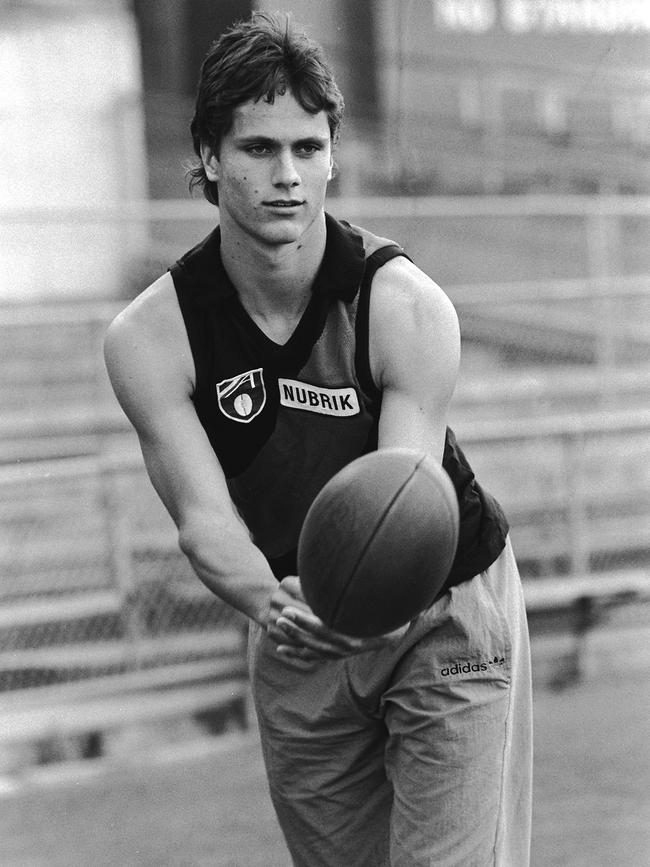
“I was copping it a lot from the half-backs and defenders,” Wanganeen says.
“I was slightly built as a youngster, I hadn’t filled out and then he threw me into the defence and I could do the chasing and playing.
“And all of a sudden I started rebounding like a crazy man and playing a rebound game which gave me the confidence to get my mojo in the AFL.
“IT WAS THE TURNING POINT OF MY CAREER AS WELL. I HAD JUST TURNED 19 WHEN I MADE THAT MOVEAND IT WAS THE REAL BEGINNING OF THE FOUNDATION OF PLAYING IN THE AFL AND MY CONFIDENCE.”
Future teammate at Port Adelaide Peter Burgoyne said this move had a profound impact on the game.
“He revolutionised the way the game was played for a defender,” Burgoyne says.
“A backman they played on their man, stopped their man from getting a kick or getting a goal and might have three or four kicks at the end of the game, a few handballs.
“But then Gavin Wanganeen comes along and he’s getting stats like an onballer, he’s attacking, he’s running ... he started that trend for a backman.”
Wagnaneen says he tried to bring attack to the art of defending.
“It was nice to be able to change the way back then that we defended,” he says.

“I just flew for marks and hunted the ball when it hit the ground in the defensive 50 and I took them on.
“I just wanted to take the ball on and get it to our midfielders and even be a bit cheeky and kick a goal myself.
“I didn’t want to play a shutdown game, for me it was about attacking footy.”
Sheedy says Wanganeen was never going to be a lockdown player in that role.
“Most of the time I don’t even think he knew his opponent,” he says.
“They had to know him because he had the ball.”
FROM HUMBLE BEGINNINGS
WANGANEEN’S CAREER ROSE to amazing heights — he won the Brownlow Medal in 1993, a premiership with Essendon, and the competition’s most courageous player that year — and then another flag in 2004 with Port Adelaide.
He was also inducted into the AFL’s Hall of Fame.
But his journey into football had a humble beginning — he grew up in the Aboriginal Housing Trust in the northern Adelaide suburb of Salisbury after moving from Port Lincoln.
“It was like living out in the Bronx a bit,” he says.
“We didn’t have much.”
Wanganeen fell in love with the game after watching his mum, Cheryl’s, uncles play footy when he was four.

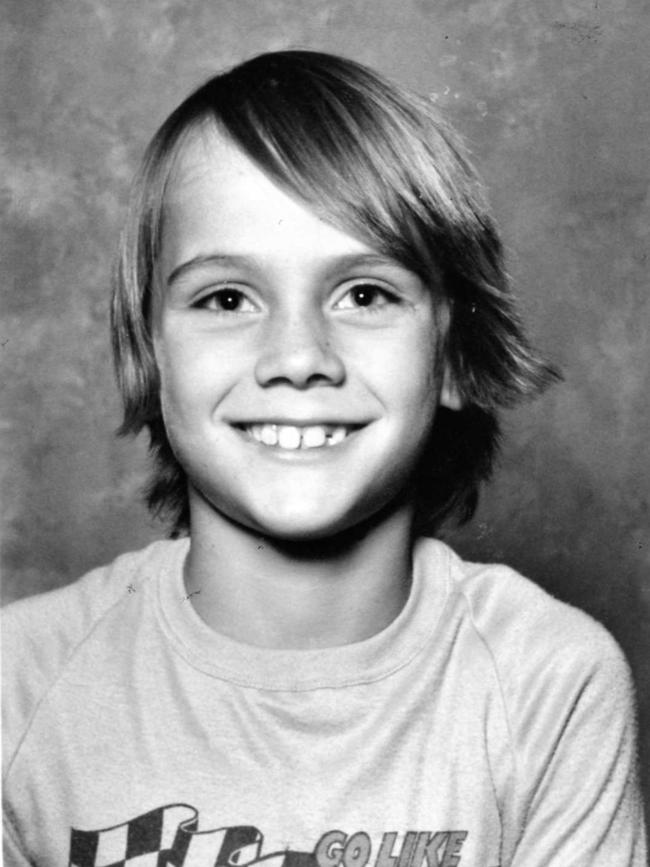
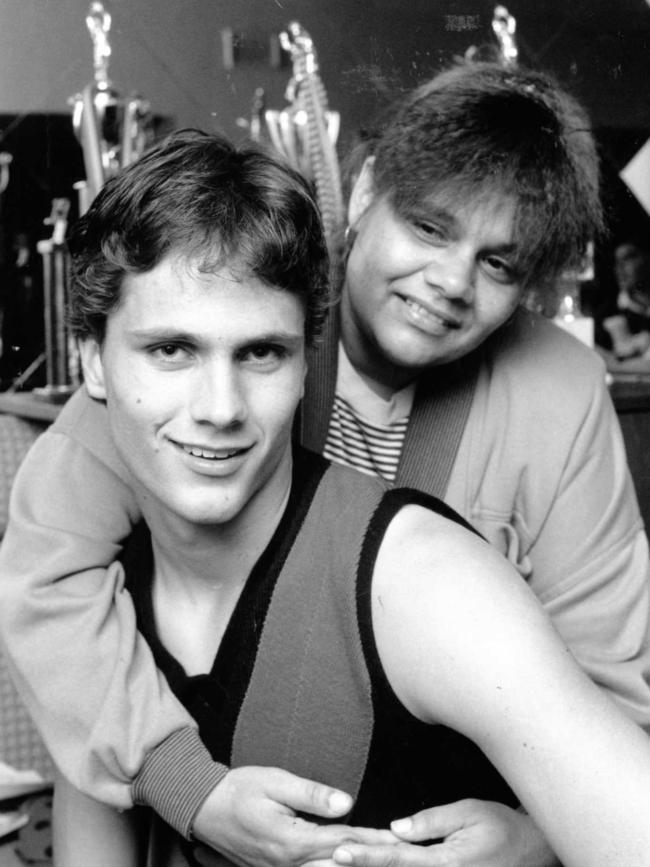
“It just stuck from there and we used to kick the footy back in Salisbury with the neighbours,” he says.
“Having a big indigenous population we’d have a lot of families coming over or we would go there and have a big kick-up with one footy and about 30 kids.
“So to get a kick you had to fight hard, and you are always competing against older boys.
“So that’s how it went, it was entrenched in our DNA as a young kid.”
Wanganeen has fond memories of growing up in the northern suburbs, ‘going to school and playing footy with the Salisbury North footy club’.
“It has helped made me who I am today and the determination I got from living out there,” he says.
“I just wanted to work hard and make something out of my life growing up in a very modest environment.”
But there was also difficulties for Wanganeen, who traces his heritage to the Kokatha people of the Far West Coast, and also has links to the Narungga on Yorke Peninsula.
“Growing up in an indigenous family and not having much there were temptations there to go down the wrong path. Which I had in front of me,” he says.
“So footy, I was one of the lucky ones in a way because I have seen a lot of relatives who got caught up and went down a different path and that makes me feel sad.
“I look at that and tell myself that could have quite easily have been me but footy saved me from a different path.”

Cheryl was part of the stolen generation, with Wanganeen — now 47 — only meeting his grandmother 14-years-ago.
He said it was a part of his mother’s story that he was learning more and more about.
“It is only as I’ve gotten older that mum has told me about it a bit more but to hear her journey and her sisters about how they were taken away from their mothers in Port Lincoln when they were very young,” he says.
“AND HEARING THE SUFFERING SHE HAS HAD TO ENDURE GROWING UP AND NOT MEETING HER MOTHER UNTIL SHE WAS CLOSE TO 50-YEARS OF AGE SO YOU COULD ONLY IMAGINE THE HARDSHIP THAT SHE HAS HAD TO ENDURE.”
“And not having her mother there growing up and being an indigenous girl with her sisters and her brothers and just a lot of heartache in the family and stories that you never forget.
“I feel for my mum you know from the suffering that she has had to endure in her life. She has had a hard life.
“But the great thing with mum is that she has a lot of resilience and she always has a smile on her face. She is an inspirational lady because she is always encouraging her kids and grandkids to put a smile on your face and go an achieve what you want to achieve in life.”
It partly this that inspires Wanganeen — a Port Adelaide board member and ambassador for the club’s Santos Power Aboriginal Cup — to try to get better outcomes for his people.
“Look, Aboriginal people come from so far back,” he says.
“Health and incarceration rates are where they should not be and I understand that, I get that, I grew up understanding that.”
COMING HOME TO PORT
THERE WAS NO RESTAURANT franchise, heavily rumoured, that contributed to Wanganeen coming back to Adelaide for Port’s foray into the AFL after six successful seasons at Essendon.
“There was a rumour going around that I got a McDonald’s franchise in Adelaide and that’s why I came back,” he says.
“And I’m still hearing that today, people ask me about it.
“I wish I did, they print money.”
The real reason Wanganeen returned home was just down to excellent timing, and some amazing luck in the first place.
“Believe it or not certain parts of Salisbury was in the Port zone so I wasn’t in Central Districts,” he says.
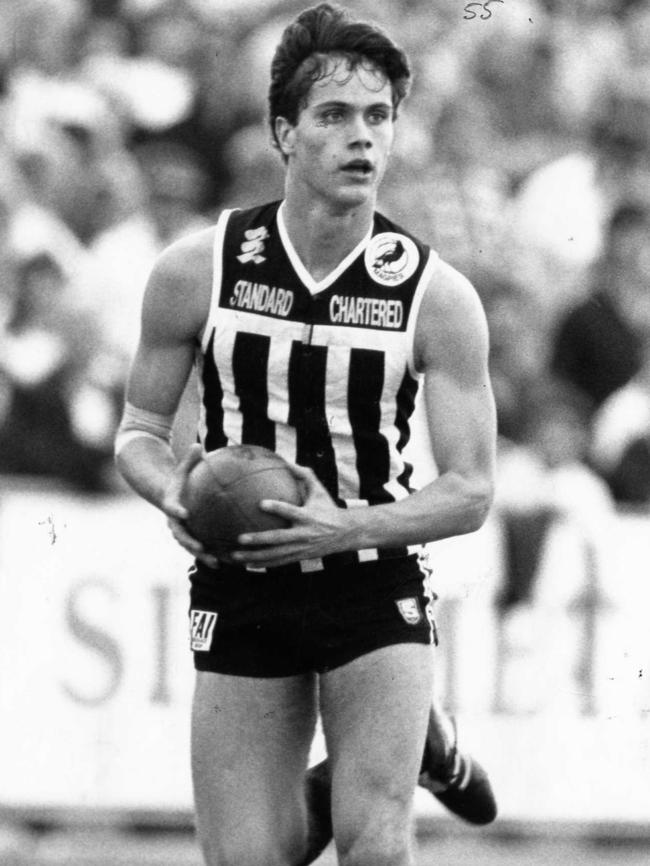
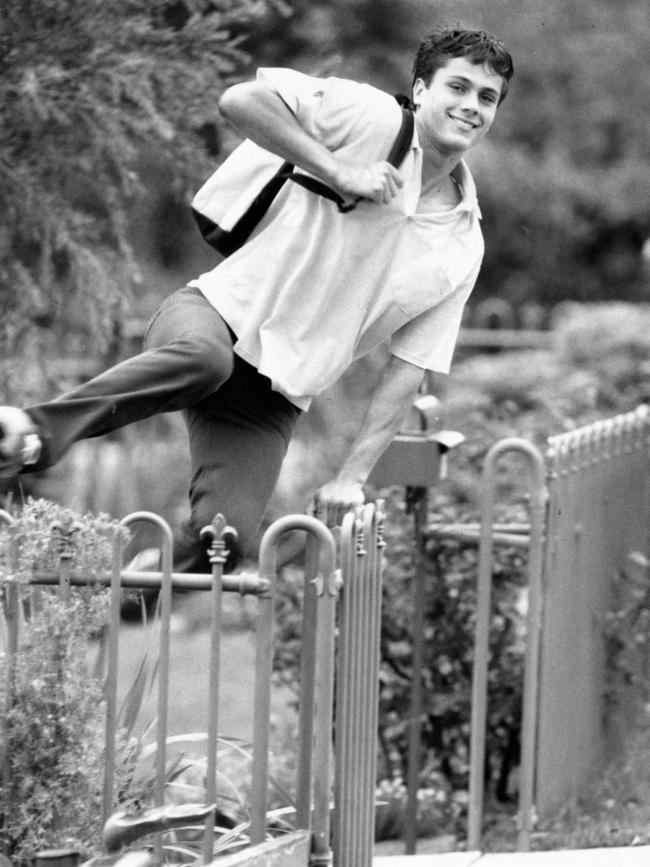

“How Port got that bit of Salisbury is amazing to be honest.
“It was a hard decision to make (to return to Adelaide) because I had a great career at Essendon (playing 127 games).
“But the only thing that got me there was that I fell out of contract that year. How’s that, so if the club had extended my contract a couple of years prior I may have had to wait a few years and it may have not eventuated.
“But the call to come home to South Australia was strong, I loved Adelaide and my connection to Port Adelaide and I knew that the AFL Port Adelaide was going to be a big journey as well.
“To be a part of that was special and it was a big decision I made at 23 to come back and be a part of it but I’m very grateful that I did.”



Despite his young age, Wanganeen was made Port’s first ever captain in the AFL.
“I liked to lead by example and play extremely hard at the football, at the body, put my body on the line contest after contest and it was a proud moment to be the first captain in the AFL journey,” he says.
But his greatest moments for the Power came arguably after he relinquished the role, getting the closest a Port Adelaide player has to winning the Brownlow — a vote off in 2003 — and then kicking four goals after half-time to help win the 2004 Premiership.
“He could play up the ground as well, which you saw when Port Adelaide won the 2004 Grand Final,” Sheedy says.
“They moved him up into the midfield and he kicked four goals and that’s a very difficult thing to do when you are playing most of your career in defence.”
Burgoyne, who roomed with Wanganeen at the Power, said this cemented his legacy as a club great.
“Port Adelaide’s greatest ever player, full stop,” he says.
“Black, white, brindled it doesn’t matter. He was the best I ever played with.”
MAKING INDIGENOUS HISTORY
WHILE WANGANEEN FINISHED within a vote of the 2003 Brownlow Medal, he had already made history 10-years prior.
After his positional shift to defence earnt him All-Australian selection in 1992, Wanganeen thrilled the competition a year later as the ‘Baby Bombers’ took out the flag and he became the first Aboriginal player to win the Brownlow Medal — and at 20 the youngest since 1936.
Sheedy says it was an achievement with far-ranging impacts.
“Well it is a great credit to him to be honest, it was 1993 and I don’t know if many people realised but there wasn’t a lot of Aboriginal players who played before Gavin,” he says.
“It would have given young indigenous kids an enormous amount of confidence, no doubt.”

Burgoyne says he was inspired by that achievement.
“Just him winning a Brownlow at 20 full stop that goes to show just what type of player he is,” he says.
“Just watching him you could see he was special and him winning a Brownlow you always knew that this guy was going to be one of the best ever footballers, black or white, full stop.
“IF YOU PICKED A TEAM OF THE CENTURY NOW, YOU HAVE TO HAVE GAVIN WANGANEEN IN THE BACK POCKET.”
Wanganeen was also the first Aboriginal player to play 300 games, with many of the current playing cohort both indigenous and non-Indigenous referring to him as their idol.
“Looking back on it and to hear I was the first indigenous player to win a Brownlow and representing my mob from the West Coast of South Australia,” he said.
“They were extremely proud… and it did remind me of my heritage and the family stories and connection back to country on that side of my family was very special.
“But now I’m a bit older I hear a lot of the current indigenous players and even some who have recently finished who were inspired by my career and that makes me real proud.”
STANDING UP TO RACISM
SHEEDY TELLS EVERYONE when asked about Wanganeen “that I coached the George Clooney” of the AFL.
“He’s the best looking guy, when we signed Gavin Wanganeen up we had about 5000 females sign up as members,” Sheedy says.
“So it wasn’t just great on the field, it was great off the field for the club.”
Wanganeen himself says it might not have been when he was signed up by Essendon.
“It was probably after I played half a dozen games, they wouldn’t have known too much about me before then,” he says.
“Maybe six months in.”
But Wanganeen felt the love from crowds in Melbourne — until some people found out he was a light-skinned Aboriginal man.

“I think the younger players have a smoother path because of guys like Nicky Winmar and Michael Long who stood up to racism back in the day,” he says.
“Even myself, not saying I stood up for it, because there was a time as a light-skin Aboriginal person when people realised I was an Aboriginal I actually got racially abused at the MCG on two occasions.
“But Michael actually stood up to it and the policies, the racial vilification rule was brought in and it was no longer tolerated.
“It was a wonderful decision by the AFL to bring in a rule that protects indigenous players.”
Immensely proud of Port and Essendon’s work with their respective indigenous programs, and Reconciliation Action Plans, Wanganeen has also been involved with the indigenous Players Alliance.
He said nurturing the love indigenous communities have for footy can lead to better outcomes.
“It is a culture within their culture. Football is something that we love and we get inspired by the earlier champs and so on,” he says.
“I’ve got a theory, I could be wrong but maybe it is in our DNA going back thousands and thousands of years when you had to chase a kangaroo for dinner
“You have to be agile on your feet, and the running is instinctive, knowing when to cut and run, I don’t know maybe it has to do with hunting, you had to get on your bike and run hard and be agile to get the kangaroo or the emu for a meal.
“I think it could be entrenched in the hunting skills in the DNA.
“That’s my theory anyway.”


Add your comment to this story
To join the conversation, please log in. Don't have an account? Register
Join the conversation, you are commenting as Logout
‘Devastated’ Dees to own horror mistake – but who’s to blame?
Amid all the chaos at Marvel Stadium on Sunday, an answer to a big question went missing – which Demon was at fault? Simon Goodwin speaks on the 6-6-6 blunder that cost his side the game.
AFL fans demand answers over free kick
Footy fans are demanding answers from the umpires after a Richmond player was awarded a contentious free kick on Sunday.